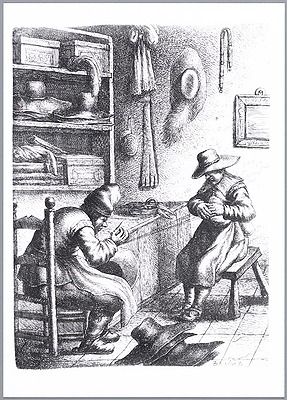
One who made and sold hats. Samuel Edsall, hatter, worked and probably lived in Block F, House 7.
Beaver pelts from New Netherland were shipped to Amsterdam and Hamburg and subsequently to Muscovy, where they were processed into felt.
The hatter worked from blocks or forms and bolts of fabric to shape his hats. He cut and steamed felt fabric for men’s hats onto the forms, first forming the crown, and then attaching the brim to the crown, stiffening the hat with glue sizing. He then decorated the hat with feathers, buckles, ribbons, and braid, and so on, to the buyer’s specification. Hatters made only men’s hats.
In images from the seventeenth-century Netherlands, the ordinary worker or artisan (male) is usually portrayed wearing a broad-brimmed, high-crowned hat, or a soft, brimless, close-fitting cap. Older women are shown wearing “matron’s caps,” whether indoors or out, or perhaps a broad straw hat. Younger women are seen wearing kerchiefs on their heads or bonnets tied under their chins The same hat styles would have been worn in New Netherland, although there are only a few depictions of them.
Hat styles revealed social status. The higher one’s social status, the fancier the hat. Lace caps were worn by females of higher status, both children and adults. Margareta Schuyler’s inventory from 1711 in Albany lists 9 little caps, 1 white silk hood, 11 coifs with ties, 1 old white veil, and 12 “cornet mutie” (a type of woman’s head covering). Special hats were reserved for occasions, such as funerals. Mourning hats worn at funerals were tall and broad-brimmed and adorned with long black scarves and bows (male).
Fashionable men’s hats made of felted beaver fur were in demand in Europe in the seventeenth century to such an extent that it caused a decline in the supply for this type of fur and thus of the beaver itself. This fashion for beaver hats and collars declined slowly after 1660.
Donna R. Barnes and Jane ten Brink Goldsmith, Street Scenes: Leonard Bramer’s Drawings of 17th-Century Dutch Daily Life (Hempstead, NY: Hofstra University, 1991).
“The Beaver Fur Hat,” www.whiteoak.org.
The Etching above is
Hoedemakeer (Hat Maker)
J.G. Van Vliet
1635

